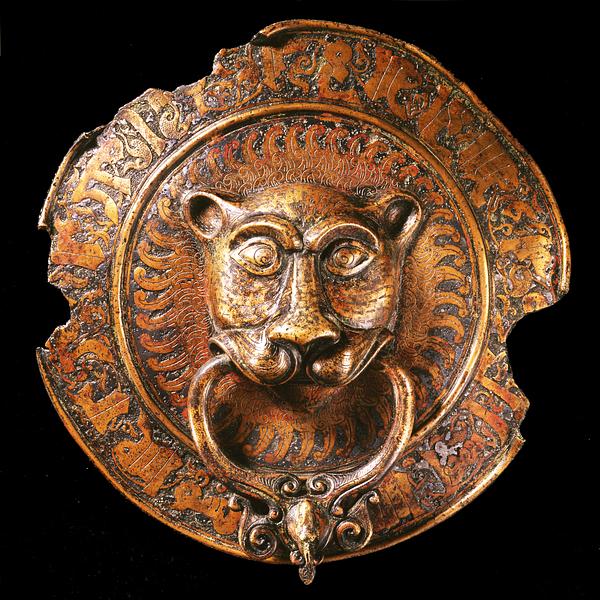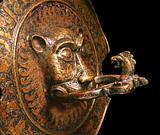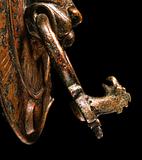Door knocker, cast and engraved bronze, inlaid with niello
Southern Italy; 11th century
Diam: 44.3 cm
This sculptural masterpiece of a door knocker is dominated by a lion’s head in whose jaws hangs a combination of a handle and a knocker designed as a ring embellished with a cock. Around the finely stylized mane is a Kufi inscription on a black niello ground. Niello is an alloy of silver, lead, copper, or bismuth sulfides that is ground to a powder and then melted into hollows in the object. The inscription proclaims the Muslim profession of faith: “In the name of God, the Merciful, the Compassionate. I testify that there is no god but God and that Muhammad is the messenger of God.”
Related door knockers, but with pseudo-Arabic inscriptions, have been found on the doors of Christian churches in southern Italy from the beginning of the 12th century, when older or contemporary Islamic models like this one were undoubtedly copied.
Inv. no. 50/2000
Published in:
Christie's, London, 10/10-2000, lot 276;
Kjeld von Folsach: Art from the World of Islam in The David Collection, Copenhagen 2001, cat.no. 458;
Joachim Meyer and Peter Northover: “A newly acquired Islamic lion door knocker in the David Collection” in Journal of the David Collection, 1, 2003, pp. 48-71;
Wilfried Seipel (ed.): Nobiles officinaedie könglichen Hofwerkstätten zu Palermo zur Zeit der Normannen und Staufer im 12. und 13. Jahrhundert, Milano 2004, cat.no. 19;
Sheila S. Blair and Jonathan M. Bloom (eds.): Cosmophilia. Islamic Art from the David Collection, Copenhagen, McMullen Museum of Art, Boston College, Boston 2006, cat.no. 103, and pp. 42-43;
Joachim Meyer: “The body language of a parrot: an incense burner from the Western Mediterranean” in Journal of the David Collection, 4, 2014, p. 29, fig. 4;
Persis Berlekamp: “Symmetry, sympathy, and sensation: talismanic efficacy and slippery iconographies in early thirteenth-century Iraq, Syria, and Anatolia” in Representations, 2016, 133, figs. 27-29, p. 94;
Julian Raby: “The inscriptions on the Pisa Griffin and the Mari-Cha Lion : from banal blessings to indices of origin” in Anna Contadini (ed.): The Pisa griffin and the Mari-Cha lion : metalwork, art and technology in the medieval islamicate Mediterranean, Pisa 2018, pp. 305-360;





